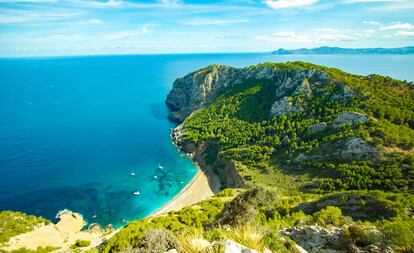Five travel ideas to discover nature in Spain
From sequoias in Cantabria to the largest community of storks in La Rioja, here is a selection of places that outdoor lovers will not want to miss

Nearly a fourth of the world’s species of flora and fauna are at risk of going extinct in the coming decades, according to the official website for World Wildlife Day, which is observed on March 3 in a bid to raise awareness about the need to preserve Earth’s biodiversity. “And to get people to find out about protected spaces, and learn to value and preserve them,” says Noemí Campo, coordinator of the interpretation center at Oyambre Natural Park, in Spain’s small northern region of Cantabria.
A forest: Monte Cabezón (Cantabria)
“They are 40 meters tall and it takes three to four people to hug their trunks, but these sequoias are actually quite young,” says Campo as way of introduction to a type of tree that is often associated with other parts of the world, not to Cabezón de la Sal in northern Spain. “They survive thanks to the mild, humid weather of the coast: it’s not as hot as California [in the United States], but the sea tempers the cold.”
The origin of this grove of 848 specimens of sequoia, a tree that can live thousands of years, lies in an experiment: they were planted here in the 1940s with the goal of using them for lumber. These days, however, this is a protected spot where guided tours are possible by contacting the interpretation center (+34 942 04 94 38). “We try to use the visible degradation caused by the growing tourist numbers – over 21,000 visitors in 2019 – to make people think about our impact on nature.”
The one-hour tour, which is free, is easy for all ages and partly adapted for wheelchair use. Dates and schedules are available on the website Naturea Cantabria.
A gorge: Estrechos del Valloré (Teruel)

The historical demarcation of the Maestrazgo, which straddles parts of the provinces of Teruel and Castellón, is home to several little-known gems that make for enjoyable outdoor recreation. One of them can be reached on foot from the village of Montoro de Mezquita, around 100 kilometers northeast of the city of Teruel. The Estrechos del Valloré, a deep gorge formed by the Guadolope river, can be easily admired at close range thanks to a network of wooden walkways that afford clear views of the sheer vertical limestone cliffs. The area falls under several protection designations, including ZEPA Río Guadalope – Maestrazgo, as it is home to bird species such as Egyptian vultures, golden eagles and peregrine falcons.
The 2.5-kilometer route is easy, and it is also possible to take a detour to the lookout point of Valloré, which is an hour-long journey that includes more challenging stretches. As a reward, trekkers will be treated to fantastic views of the gorge and its jagged peaks.
A river cruise: El Tranco (Jaén)

The Natural Park of Sierras de Cazorla, Segura y Las Villas has been a biosphere reserve for more than 35 years, and it is home to a wealth of flora and fauna. “An area that does not even account for 0.5% of peninsular Spain is home to no less than 25% of the country’s plant species,” notes the park website. But if there is anything that defines the more than 200,000 hectares of protected land, it is the endless sea of pine trees that can be best admired from the solar-powered boat that takes visitors around the Tranco de Beas reservoir on weekends. The most common species are Aleppo and black pine, mixed in with Mediterranean undergrowth and shrubs, as well as tree species such as holm oak, Valencian oak and mastic, says Antonio Mudarra, one of the guides at the El Tranco center, which runs the environmentally friendly reservoir cruise.
There are two one-hour routes, one that takes visitors to the northern end of the reservoir to see the Chorreón, a 15-meter waterfall that feeds right into the reservoir, and another one that heads south to view the mountain range of Las Villas and circle the island of Cabeza de la Viña. Because the boat is silent, it makes it easier to see local fauna such as cormorants, ospreys, Iberian ibex or fallow deer.
A pristine beach: Cove of Coll Baix (Alcúdia, Mallorca)

Concealed under the elevation of Cabo Pinar, on the northeastern coast of Mallorca in the Balearic Islands, the cove of Coll Baix often goes undetected. Part of it is due to the fact that it is only accessible via a 30-minute walk. The route begins under a 16th-century watchtower, the sa Talaia d’Alcúdia, near the parking area located 200 meters from the Es Coll Baix shelter. The walk takes visitors through forests of Aleppo pine, olive trees and dwarf palms.
The 200 meters of sand and fine gravel that make up the beach are enclosed by cliffs, and there is no lifeguard so caution is advised when the sea gets choppy.
Birdwatching: San Miguel (Alfaro, La Rioja)

The proximity of the natural reserve of Sotos de Alfaro, which still preserves part of the riverside vegetation that once covered the lowlands of the Ebro, explains the presence of a huge colony of white stork inside one single building. The roof, cornices and steeples of the collegiate church of San Miguel, in Alfaro, contain more than 100 nests between January and July, when the birds raise their young. There are two good spots for watching them: the lookout point at the back of the building, and the interpretation center located in the front. In here, visitors can also monitor the storks thanks to webcams that have been placed on the towers and central nave of the church.
English version by Susana Urra.
Tu suscripción se está usando en otro dispositivo
¿Quieres añadir otro usuario a tu suscripción?
Si continúas leyendo en este dispositivo, no se podrá leer en el otro.
FlechaTu suscripción se está usando en otro dispositivo y solo puedes acceder a EL PAÍS desde un dispositivo a la vez.
Si quieres compartir tu cuenta, cambia tu suscripción a la modalidad Premium, así podrás añadir otro usuario. Cada uno accederá con su propia cuenta de email, lo que os permitirá personalizar vuestra experiencia en EL PAÍS.
¿Tienes una suscripción de empresa? Accede aquí para contratar más cuentas.
En el caso de no saber quién está usando tu cuenta, te recomendamos cambiar tu contraseña aquí.
Si decides continuar compartiendo tu cuenta, este mensaje se mostrará en tu dispositivo y en el de la otra persona que está usando tu cuenta de forma indefinida, afectando a tu experiencia de lectura. Puedes consultar aquí los términos y condiciones de la suscripción digital.
More information
Últimas noticias
Sydney Sweeney, the actress praised by Trump: ‘Women are up against what society wants them to be’
The Bolsonaro surname: An advantage or liability in Brazil’s 2026 presidential elections?
Raúl Rocha, from jet-setting with Miss Universe to arms trafficking and fuel theft
80,000 barrels of Mexican oil sent to Cuba: Havana drawn into the US–Mexico clash
Most viewed
- Reinhard Genzel, Nobel laureate in physics: ‘One-minute videos will never give you the truth’
- Pablo Escobar’s hippos: A serious environmental problem, 40 years on
- Charles Dubouloz, mountaineering star, retires at 36 with a farewell tour inspired by Walter Bonatti
- Why we lost the habit of sleeping in two segments and how that changed our sense of time
- The fall of a prolific science journal exposes the billion-dollar profits of scientific publishing











































